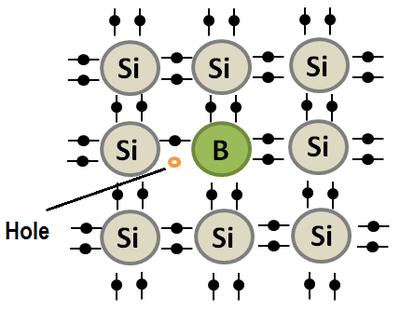Up until
now we have only described the properties of a system in equilibrium. However,
it is important to introduce what happens to a semiconductor when it
is illuminated with light.The process of interest is known as photogeneration of
charge carriers. Here electron-hole pairs are generated as light is absorbed in
a semiconductor. During the course introduction we have already mentioned that
mobile electrons and holes are formed in a semiconductor as a result of light
absorption. Now, I will explain how this process happens. Here we see a photon
incident on a semiconductor. At some point this photon can be absorbed by the
material.
Absorption
is a process, in which the electromagnetic radiation interacts with atoms of
a semiconductor, in particular with the valence electrons.This interaction can
lead to a liberation of an electron from a covalent bond. If this happens, a
valence electron is excited from an energy state in the valence band to
an available energy state in the conduction band. It is important to remember
that the excitation of an electron to an energy state in the conduction band
leaves an unoccupied energy state in the valence band. This state is then
occupied by a hole. Photo-generation results in generation of electron-hole
pairs, or in other words, the concentration of mobile electrons and the
concentration of holes in the material is increased by the same amount. However,
this excitation does not always happen. Photo-generation is limited by energy
constraints.
To
understand these constraints, we need to look at the bandgap energy of
asemiconductor.As you recall from our previous post on band diagrams, there are
no available energy statesfor electrons in the band gap.For this reason, only
if the photon energy is equal or higher than the energy of the band gap,the
photon can be absorbed and an electron-hole pair generated.However, if this
requirement is not met, the photon will simply pass through thesemiconductor
without being absorbed.You may notice that the photon used in this example is
red, whereas the photon that wasabsorbed in the previous examples was blue.This
is intentional.Red photons have less energy than blue photons.In this example
the red photon’s energy is less than that of the bandgap whereas the bluephoton
has energy larger than the bandgap.
But how do
we know the energy of a photon?The properties of the electromagnetic radiation
emitted from the Sun can be described withthe help of the wave-particle duality
concept.As a wave, this radiation propagates at the speed of light and it is
characterized by twoparameters.The first is the wavelength, which we denote
lambda.It is defined as the distance between two adjacent wave peaks.The second
is the frequency, which we denote nu, representing the number of cycles
persecond.It is determined as the ratio between the speed of light and
wavelength, and it is measuredin Hertz.However, light can be seen also as a
flow of particles, which are called photons.The energy of a photon is directly
proportional to the product between the frequency andthe Planck’s constant “h”.
Let’s now
apply these concepts to determine the minimum energy that is needed to
liberatea valence electron in a silicon wafer.The band-gap energy of
crystalline silicon is equal to 1.12 eV.This is the minimum amount of energy
required for a photon to be absorbed and excite anelectron from an energy state
in the valence band to an unoccupied energy state in theconduction band.We can
now apply the relationships we just saw to determine the wavelength of
theelectromagnetic radiation corresponding to this energy value.Stop the post
now and determine the maximum wavelength that can be absorbed bysilicon.Now
let’s compare your answer with ours.First of all, we need to the determine the
frequency of light, when having an energy of 1.12electron volts.We find that
this is 2.7 times 10 to the power of 14 hertz.
Then we can
calculate the maximum wavelength of light that can be absorbed by Silicon.It
results to be 1110 nanometers.Now let’s see what this means when we want to
know which part of the solar spectrum canbe absorbed by crystalline silicon.In
this figure you can see the spectral power density of the AM1.5 spectrum in
yellow.You also can see the fraction of this spectral power density that can be
absorbed by siliconand converted into electricity in a solar cell.This is the
brown fraction of the spectrum.The red dashed line represents energy of the
band gap of Silicon expressed in wavelength oflight.Only the radiation at lower
wavelengths carries enough energy to be absorbed and excite anelectron in
crystalline silicon.
Therefore,
from the solar spectrum, only the part of the spectrum on the left hand side
ofthe dashed line can be absorbed in crystalline silicon.You may also notice
that not all of the available energy in this part of the spectrum is usedfor
generating electricity by a solar cell.This is due to a process known as
thermalization and you will learn more about this in thelight management
section of the course.As you can imagine, a semiconductor under illumination
will be no longer in an equilibriumstate.Once illuminated, the amount of
electrons and holes change with respect to the thermalequilibrium values.As
these charges are mobile, we have to understand how these charges move around
in thesemiconductor once they are excited.This will be the topic of the next post.

Comments
Post a Comment